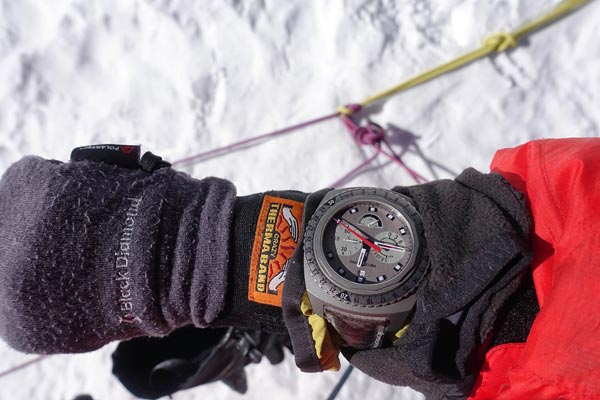The original Favre-Leuba Raider Bivouac was released in 1962 and was thus too late to witness the first recorded ascent of Mount Everest by Edmund Hillary and Tenzing Norgay in 1953. But the Bivouac came out with something that would have proved valuable to the two climbers whose names went down in the history books. It was the world’s first watch with a mechanical aneroid barometer that could display air pressure and therefore be used to calculate altitude.
In its current incarnation, the Favre-Leuba Raider Bivouac 9000 is the only mechanical watch with a mechanical aneroid barometer that can display altitudes up to 9,000 metres and is therefore the only mechanical watch that can indicate the altitude at the summit of Mount Everest. As such, it was the perfect companion for American mountaineer Adrian Ballinger on his recent expedition to stand on the top of the world for the eighth time. It was an expedition that saw a catastrophic failure of the team’s oxygen systems, forcing them back below the “death zone” of 8,000 metres before making a second attempt days later. For Ballinger, it was a reminder of the risks of such expeditions. “No matter how carefully we prepare, no matter how much expertise we have, and no matter how technologically advanced our tools may be, it is still a place we can only visit briefly, and only with luck in addition to all our skill,” he wrote on his blog for Favre-Leuba.

The Favre-Leuba Raider Bivouac had already proved itself on Ballinger’s team’s ascent of Cho Oyu, the world’s sixth tallest mountain, days earlier, as part of his goal to climb two 8,000 metre peaks in less than a month. As he explains, “it was essential in knowing where to place camps on the big open slopes of Cho Oyu. Himalayan climbing is all about altitude. If you know the altitude, you know where you are and how far you’ve travelled. We almost never think in terms of distance… only altitude.”
The 48mm tool watch performed flawlessly during both expeditions, taking in its stride the tough conditions where the jet stream grazes the tops of the 8,000 metre peaks. Thanks to the on-board air-tight capsule of its barometer, which is made from a special alloy, it can measure air pressure, which in addition to displaying altitude when set against a known reference point, also allows climbers to predict weather changes based on variations in barometric pressure. Such information can help mountain climbers with vital decisions on whether to push for a summit or stop and make camp.







